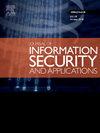Hybrid prediction error and histogram shifting method for reversible data hiding in video system
IF 3.8
2区 计算机科学
Q2 COMPUTER SCIENCE, INFORMATION SYSTEMS
Journal of Information Security and Applications
Pub Date : 2025-02-19
DOI:10.1016/j.jisa.2025.104007
引用次数: 0
Abstract
With the rapid advancement of communication technology, ensuring the security of information transmission has become increasingly crucial. In today's digital landscape, video has emerged as one of the most popular media formats. Video Reversible Data Hiding (RDH) involves embedding information or secret data within a video file while preserving the perceived quality of the resulting stego video. This technique enables the receiver to perfectly restore the original video and extract the embedded secret data. Achieving high-quality stego files while maintaining sufficient capacity for secret data remains a significant challenge. This research proposes a novel reversible video data hiding method that utilizes an innovative prediction error algorithm for intra-frame pixel value prediction error calculation. The algorithm generates sharp histograms based on these prediction errors, with sharper histograms corresponding to a higher Peak signal-to-noise ratio (PSNR) of the stego video. Additionally, the method incorporates an adaptive zero-point system to identify which zero point that require minimal histogram shifts, thus achieving adaptive effects within each frame by applying different shifts based on frame characteristics. The proposed prediction error algorithm enhances the histogram shifting effects and addresses the limitation of not embedding data in the first frame while maintaining superior PSNR. Extensive experimental analysis demonstrates that proposed method surpasses various existing techniques in terms of steganographic video quality.
视频系统中可逆数据隐藏的混合预测误差和直方图移位方法
随着通信技术的飞速发展,确保信息传输的安全变得越来越重要。在当今的数字环境中,视频已经成为最受欢迎的媒体格式之一。视频可逆数据隐藏(RDH)涉及在视频文件中嵌入信息或秘密数据,同时保持所得到的隐写视频的感知质量。该技术使接收机能够完美地还原原始视频并提取嵌入的秘密数据。实现高质量的stego文件,同时保持足够的秘密数据容量仍然是一个重大挑战。本研究提出了一种新的可逆视频数据隐藏方法,该方法利用一种创新的预测误差算法来计算帧内像素值的预测误差。算法根据这些预测误差生成清晰的直方图,更清晰的直方图对应着隐写视频的峰值信噪比(PSNR)更高。此外,该方法结合自适应零点系统来识别哪些零点需要最小的直方图位移,从而通过基于帧特征施加不同的位移来实现每帧内的自适应效果。提出的预测误差算法增强了直方图偏移效果,解决了第一帧不嵌入数据的限制,同时保持了较高的PSNR。大量的实验分析表明,该方法在隐写视频质量方面优于现有的各种技术。
本文章由计算机程序翻译,如有差异,请以英文原文为准。
求助全文
约1分钟内获得全文
求助全文
来源期刊

Journal of Information Security and Applications
Computer Science-Computer Networks and Communications
CiteScore
10.90
自引率
5.40%
发文量
206
审稿时长
56 days
期刊介绍:
Journal of Information Security and Applications (JISA) focuses on the original research and practice-driven applications with relevance to information security and applications. JISA provides a common linkage between a vibrant scientific and research community and industry professionals by offering a clear view on modern problems and challenges in information security, as well as identifying promising scientific and "best-practice" solutions. JISA issues offer a balance between original research work and innovative industrial approaches by internationally renowned information security experts and researchers.
 求助内容:
求助内容: 应助结果提醒方式:
应助结果提醒方式:


